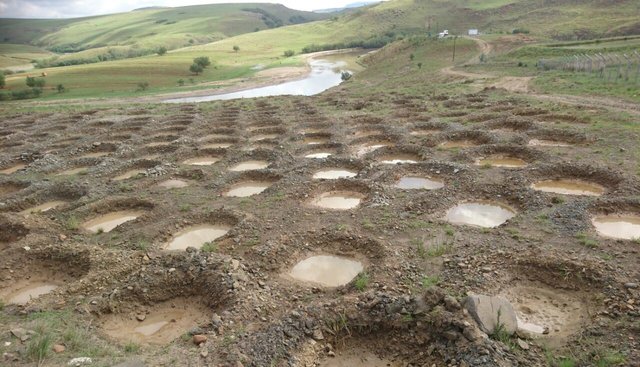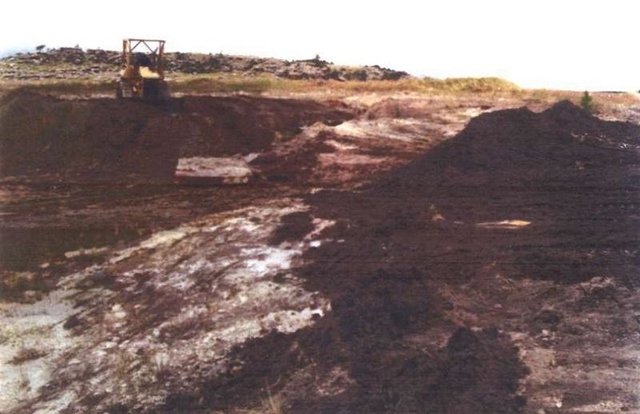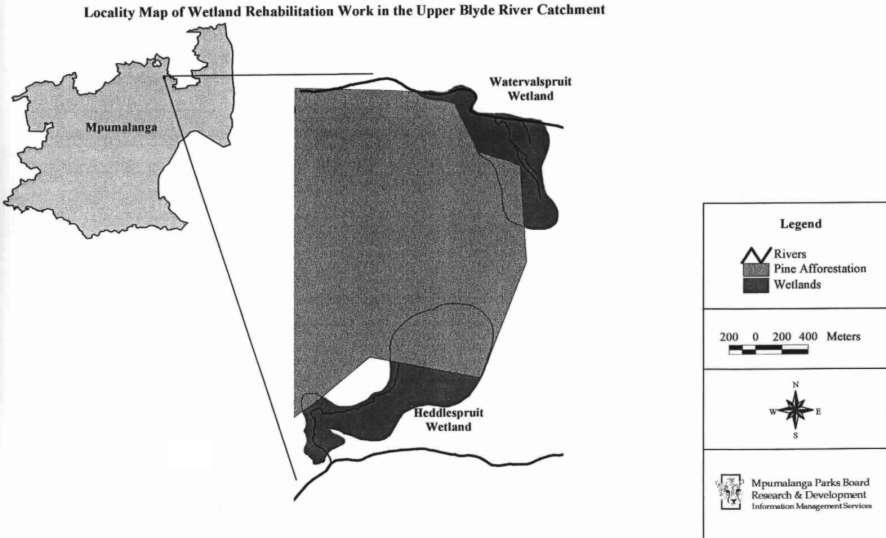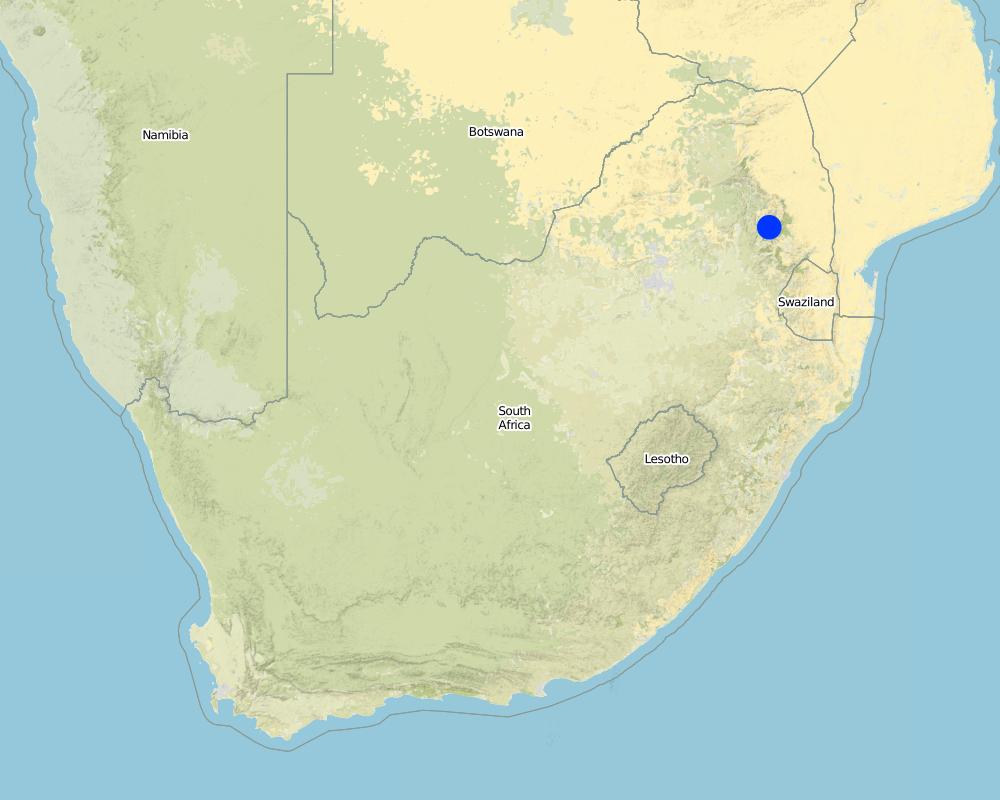Working for Water Wetland rehabilitation [South Africa]
- Creation:
- Update:
- Compiler: Unknown User
- Editor: –
- Reviewer: Fabian Ottiger
approaches_2414 - South Africa
View sections
Expand all Collapse all1. General information
1.2 Contact details of resource persons and institutions involved in the assessment and documentation of the Approach
Key resource person(s)
SLM specialist:
Bronkhorst Frik
South Africa
SLM specialist:
Landström Anton
013 23 52 395
Mpumalanga Parks Board, P.O. Box 4442, Lyndenburg 1120,
South Africa
1.3 Conditions regarding the use of data documented through WOCAT
The compiler and key resource person(s) accept the conditions regarding the use of data documented through WOCAT:
Yes
1.4 Reference(s) to Questionnaire(s) on SLM Technologies

Pitting to restore degraded catchment of Mount Fletcher … [South Africa]
To improve infiltration and vegetation cover, by creating small pits on bare soil, which capture runoff and reduce erosion.
- Compiler: Dirk Pretorius

Wetland rehabilitation [South Africa]
To rehabilitate/stabilise distorted wetlands as close as possible to its original state/function.
- Compiler: Unknown User
2. Description of the SLM Approach
2.1 Short description of the Approach
To improve the quality & quantity of water production and biodiversity in the Blyde River catchment area.
2.2 Detailed description of the Approach
Detailed description of the Approach:
Aims / objectives: Stabilise, landscape and re-vegetate degraded wetlands in the upper Blyde River catchment. The objective was to re-instate the previous water table and vegetation by slowing down run-off through the building of gabions, landfills, reshaping and hydroseeding. Participants: Government funding
2.3 Photos of the Approach
2.5 Country/ region/ locations where the Approach has been applied
Country:
South Africa
Region/ State/ Province:
Mpumalanga
Map
×2.6 Dates of initiation and termination of the Approach
Indicate year of initiation:
1999
2.7 Type of Approach
- project/ programme based
2.8 Main aims/ objectives of the Approach
The Approach focused mainly on SLM with other activities (Catchment management)
To rehabilitate degraded wetlands in the upper Blyde Rive catchment area To employ jobless people in adjacent local community
The SLM Approach addressed the following problems: Stopping head-cut erosion, landscape old mine trenches, re-vegetate area of bare soil, re-visit burning programme
2.9 Conditions enabling or hindering implementation of the Technology/ Technologies applied under the Approach
social/ cultural/ religious norms and values
- hindering
Ignorance of forestry, mining & local communities about the importance of these natural systems
Treatment through the SLM Approach: Capacity building & extension work
availability/ access to financial resources and services
- hindering
Rehabilitation is an 'extra' workload. Current budget does not allow for this
Treatment through the SLM Approach: External funding: Working for Water, Landcare
legal framework (land tenure, land and water use rights)
- enabling
The existing land ownership, land use rights / water rights greatly helped the approach implementation: Both sites where work has been done is on conservation land
- hindering
Powerless to address illegal activities
Treatment through the SLM Approach: Inadequate policing
knowledge about SLM, access to technical support
- hindering
Not much is known on rehabilitation in this veld type
Treatment through the SLM Approach: Use this as an opportunity to build up information
3. Participation and roles of stakeholders involved
3.1 Stakeholders involved in the Approach and their roles
- local land users/ local communities
Specific ethnic groups: Previously disadvantage communities
Specialist in this field are mainly men
- SLM specialists/ agricultural advisers
- national government (planners, decision-makers)
Several government departments; working for water
If several stakeholders were involved, indicate lead agency:
Frik Bronkhorst, Anton Linström (Business plan, layout of rehabilitation work), Peter Steyn (landscaping, employment)
3.2 Involvement of local land users/ local communities in the different phases of the Approach
| Involvement of local land users/ local communities | Specify who was involved and describe activities | |
|---|---|---|
| initiation/ motivation | none | survey; Wetland condition survey identified these two wetlands as priorities for rehabilitation work |
| planning | none | consultation; Inputs of various specialists were used to draw up a business plan |
| implementation | external support | Contractor, casual labour; Landscaping contractor was employed to implement business plan |
| monitoring/ evaluation | passive | reporting, measurements/observations; Fixed point photography & vegetation transects, water quality tests. Report is available |
| Research | none |
3.4 Decision-making on the selection of SLM Technology/ Technologies
Specify who decided on the selection of the Technology/ Technologies to be implemented:
- mainly land users, supported by SLM specialists
Explain:
consultative. Also land user driven Land-users (Mpumalanga Parks Board with advice from Frik Bronkhorst). Men make decisions, no women in the specific posts.
Decisions on the method of implementing the SLM Technology were made by mainly by land users supported by SLM specialists. consultative. Also land user driven
4. Technical support, capacity building, and knowledge management
4.1 Capacity building/ training
Was training provided to land users/ other stakeholders?
Yes
- SWC specialists
Form of training:
- on-the-job
- demonstration areas
Subjects covered:
Rehabilitation and importance of the wetland ecosystem in water management
4.2 Advisory service
Do land users have access to an advisory service?
Yes
Specify whether advisory service is provided:
- at permanent centres
Describe/ comments:
Name of method used for advisory service: Mpumalanga Wetland Project, Mpumalanga Parks Board; Key elements: Capacity building among land users, Wetland conservation, Wetland rehabilitation; 1) Advisory service was carried out through: government's existing extension system. Extension staff: mainly government employees 2) Target groups for extension: land user
Advisory service is quite adequate to ensure the continuation of land conservation activities; Got the expertise and gained much from this activity to contribute
4.3 Institution strengthening (organizational development)
Have institutions been established or strengthened through the Approach?
- yes, a little
Specify the level(s) at which institutions have been strengthened or established:
- local
Specify type of support:
- capacity building/ training
4.4 Monitoring and evaluation
Is monitoring and evaluation part of the Approach?
Yes
Comments:
bio-physical aspects were regular monitored through measurements
technical aspects were regular monitored through measurements
There were no changes in the Approach as a result of monitoring and evaluation
4.5 Research
Was research part of the Approach?
Yes
Specify topics:
- ecology
Give further details and indicate who did the research:
Vegetation transects to monitor dynamics, fixed point photographs, water quality tests
Research was carried out both on station and on-farm
5. Financing and external material support
5.1 Annual budget for the SLM component of the Approach
If precise annual budget is not known, indicate range:
- 10,000-100,000
Comments (e.g. main sources of funding/ major donors):
Approach costs were met by the following donors: government (national): 100.0%
5.2 Financial/ material support provided to land users
Did land users receive financial/ material support for implementing the Technology/ Technologies?
No
5.3 Subsidies for specific inputs (including labour)
If labour by land users was a substantial input, was it:
- voluntary
Comments:
Parks Board officials/advisory, supervision & monitoring
5.4 Credit
Was credit provided under the Approach for SLM activities?
No
6. Impact analysis and concluding statements
6.1 Impacts of the Approach
Did the Approach help land users to implement and maintain SLM Technologies?
- No
- Yes, little
- Yes, moderately
- Yes, greatly
Too early to comment Project has only just finished
6.3 Sustainability of Approach activities
Can the land users sustain what has been implemented through the Approach (without external support)?
- yes
6.4 Strengths/ advantages of the Approach
| Strengths/ advantages/ opportunities in the compiler’s or other key resource person’s view |
|---|
| Job creation (How to sustain/ enhance this strength: Governmental funding) |
| Working for water principle (How to sustain/ enhance this strength: Governmental funding) |
| Opportunity to be exposed to the practical side of wetland rehabilitation (How to sustain/ enhance this strength: Rehabilitation of others wetlands and monitoring the present situation) |
| Contribute towards the natural hydrological regime of the catchment (How to sustain/ enhance this strength: Monitoring) |
| Opportunity for land users to combine ideas and to improve relationships (How to sustain/ enhance this strength: Work towards a better environment) |
6.5 Weaknesses/ disadvantages of the Approach and ways of overcoming them
| Weaknesses/ disadvantages/ risks in the compiler’s or other key resource person’s view | How can they be overcome? |
|---|---|
| No action from a steering committee | Get steering committee up and going |
| Lack of practical experiences on wetland rehabilitation | Get more experiences |
7. References and links
7.1 Methods/ sources of information
- field visits, field surveys
- interviews with land users
Links and modules
Expand all Collapse allLinks

Pitting to restore degraded catchment of Mount Fletcher … [South Africa]
To improve infiltration and vegetation cover, by creating small pits on bare soil, which capture runoff and reduce erosion.
- Compiler: Dirk Pretorius

Wetland rehabilitation [South Africa]
To rehabilitate/stabilise distorted wetlands as close as possible to its original state/function.
- Compiler: Unknown User
Modules
No modules





